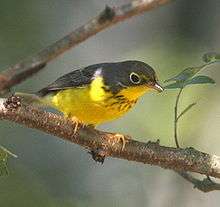Canada warbler
| Canada warbler | |
|---|---|
 | |
| Male | |
| Scientific classification | |
| Kingdom: | Animalia |
| Phylum: | Chordata |
| Class: | Aves |
| Order: | Passeriformes |
| Family: | Parulidae |
| Genus: | Cardellina |
| Species: | C. canadensis |
| Binomial name | |
| Cardellina canadensis (Linnaeus, 1766) | |
 | |
| Range of C. canadensis Breeding range Wintering range | |
| Synonyms | |
|
Wilsonia canadensis | |
The Canada warbler (Cardellina canadensis) is a small 13 cm (5.1 in) long songbird of the New World warbler family.
Description
These birds have yellow underparts, blue-grey upperparts and pink legs; they also have yellow eye-rings and thin, pointed bills. Adult males have black foreheads and black necklaces. Females and immatures have faint grey necklaces. They have yellow "spectacles" round the eyes.
The Canada warbler is the host to the parasite Apororhynchus amphistomi.[2]

Ecology
Breeding
They breed generally in dense secondary growth forests, red maple swamps or high elevation alpine forests. These forests are located across Canada, east of the Rockies, and in the eastern United States. The nests are shaped like open cups and are placed on the ground in a damp, heavily wooded location, generally characterized by a sphagnum hummock, tree stumps or other woody debris. The female lays four to five eggs and incubates for about 12 days. The chicks remain in the nest for about 10 days after hatching and are dependent on their parents for two to three weeks after they leave the nest.[3]
These birds migrate to northern South America, and are very rare vagrants to Western Europe.
Feeding
They forage actively in vegetation or on the ground, and they often catch insects in flight. These birds mainly eat insects. They forage in flocks in their winter habitat.
Song
The ![]() song of this bird is loud and highly variable, resembling chip chewy sweet dichetty. Their calls are low chup's.
song of this bird is loud and highly variable, resembling chip chewy sweet dichetty. Their calls are low chup's.
Status
Canada warblers' numbers have declined due to loss of suitable habitat and the species has been assessed as "threatened" by the Committee on the Status of Endangered Wildlife in Canada.[4] The IUCN, however, ranks the Canada warbler as a species of least concern.[1]
The Canadian population, which accounts for 85% of the global population, is estimated at roughly 2.7 million individuals.[3]
The Canada warbler is protected at the federal level in both Canada and the United States.[3]
Canada warblers have been seen twice in Europe. The first record was seen in Iceland, and the second was of a first-winter female which was found in Kilbaha, County Clare, Ireland in October 2006.
In art
John James Audubon illustrates the Canada warbler in Birds of America (published, London 1827-38) as Plate 73 entitled "Bonaparte's Flycatching-Warbler - Muscicapa bonapartii". The single female (now properly identified as a Canada warbler) is shown perched in a Great Magnolia (Magnolia grandiflora) branch that was painted by Joseph Mason. The final, combined image was engraved and colored by Robert Havell Jr. at the Havell workshops in London. The original painting was purchased by the New York Historical Society.
References
- 1 2 BirdLife International (2009). "Wilsonia canadensis". IUCN Red List of Threatened Species. Version 2011.2. International Union for Conservation of Nature. Retrieved 3 June 2012. Database entry includes justification for why this species is of least concern
- ↑ Byrd. Helminth Parasites. pp. 391–410.
- 1 2 3 "Species Profile: Canada Warbler". http://www.registrelep-sararegistry.gc.ca. Species at Risk Public Registry, Government of Canada. 2014-05-29. Retrieved 5 Jun 2014. External link in
|website=(help) - ↑ "Warbler, Canada". http://www.cosewic.gc.ca. Committee on the Status of Endangered Wildlife in Canada (COSEWIC), Government of Canada. 2011-11-07. Retrieved 5 Jun 2014. External link in
|website=(help)
External links
| Wikimedia Commons has media related to Cardellina canadensis. |
| Wikispecies has information related to: Cardellina canadensis |
- "Canada warbler media". Internet Bird Collection.
- Canada warbler Species Account - Cornell Lab of Ornithology
- Canada warbler - Wilsonia canadensis - USGS Patuxent Bird Identification InfoCenter
- Canada warbler photo gallery at VIREO (Drexel University)
